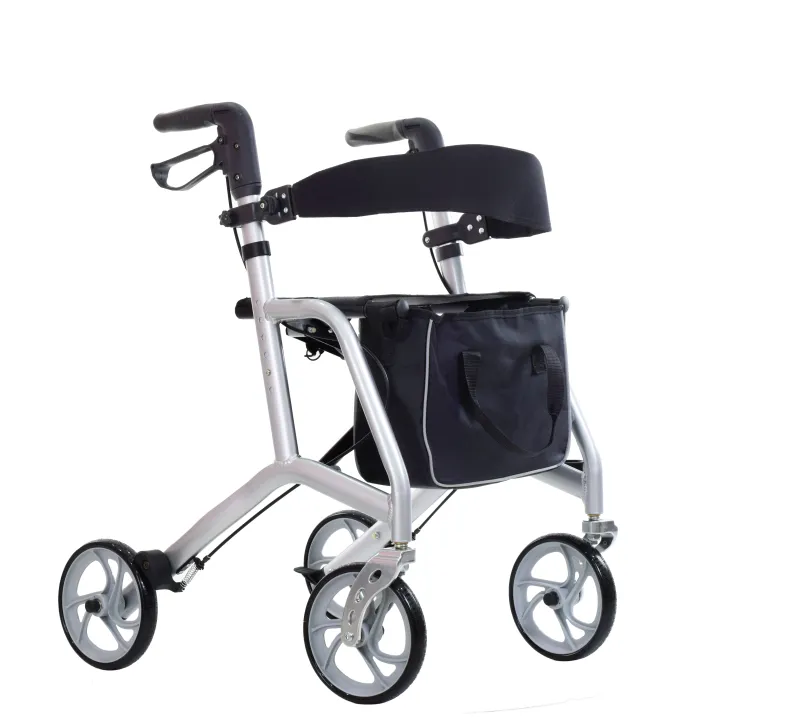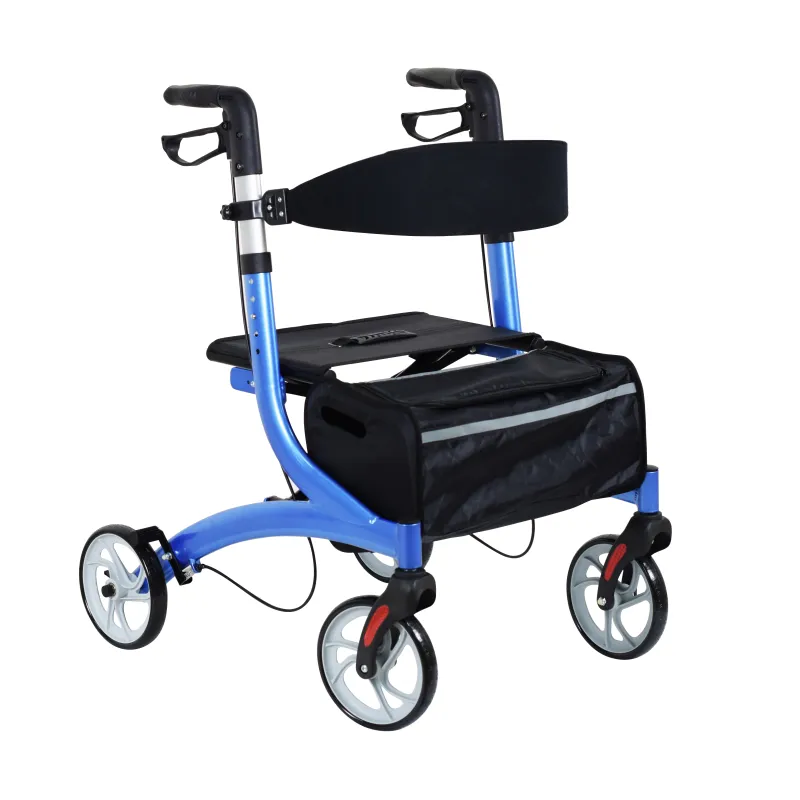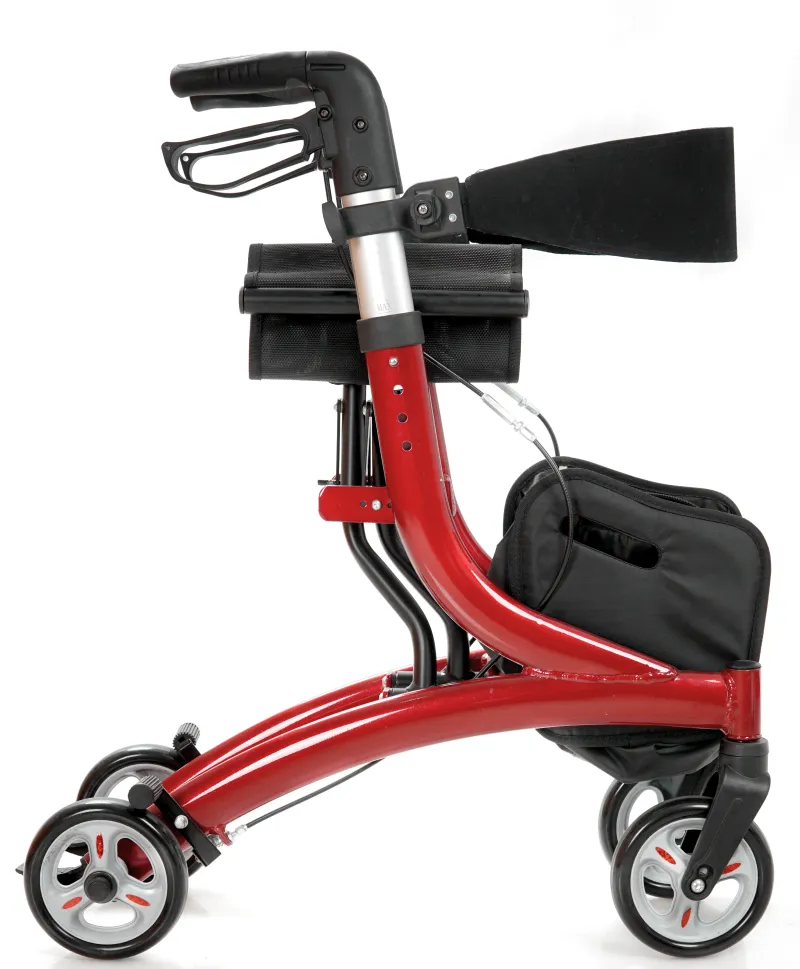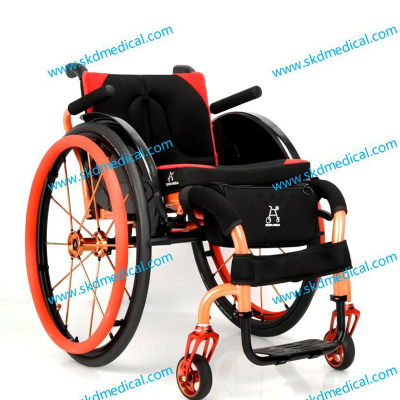
Zahlt Medicare für einen Rollator mit Rädern und Sitz?
2024-12-10 15:30
Während der Nutzung eines Rollators sollten Patienten regelmäßig den Zustand des Geräts überprüfen, um sicherzustellen, dass es immer in einwandfreiem Zustand ist. Wenn das Gerät Probleme aufweist oder ersetzt werden muss, können sich Patienten an den Lieferanten wenden, um es reparieren oder ersetzen zu lassen.
Welche Einschränkungen gibt es bei der Erstattung von Rollatoren mit Rädern?Obwohl Medicare Teil B dieKosten für Rollatoren mit Rädern

gibt es noch einige Einschränkungen dieser Erstattungsrichtlinie:
1. Medizinische Notwendigkeit des Gerätes:
Wie bereits erwähnt, zahlt Medicare nicht für Geräte, für die kein eindeutiger medizinischer Bedarf besteht. Wenn der Patient beispielsweise über eine gute Mobilität verfügt oder einen Rollator nur aus Bequemlichkeit verwendet, übernimmt Medicare die Kosten nicht.

2. Nur für Geräte zur Heimnutzung:
Medicare Teil B ist hauptsächlich für langlebige medizinische Geräte gedacht, die Patienten zu Hause verwenden. Wenn der Patient das Gerät nur in einem Krankenhaus oder einer Langzeitpflegeeinrichtung verwendet, übernimmt Medicare die Kosten nicht.
3. Auswahl des Ausrüstungslieferanten:Wie bereits erwähnt, müssen Patienten das Gerät von einem Medicare-zertifizierten Anbieter kaufen oder mieten. Geräte von nicht zertifizierten Anbietern werden nicht erstattet.
Zusammenfassend lässt sich sagen: Ein Rollator mit Rädern und Sitz ist ein Hilfsmittel, das die Lebensqualität älterer und mobilitätseingeschränkter Menschen deutlich verbessern kann. In den USA kann Medicare Teil B einen Teil der Kosten für einen Rollator mit Rädern übernehmen, sofern das Gerät medizinisch notwendig ist und der Patient das korrekte Antragsverfahren befolgt.Wenn Patienten eine Kostenerstattung durch Medicare beantragen möchten, müssen sie sicherstellen, dass sie alle relevanten Bedingungen erfüllen. Dazu gehören ein ärztliches Rezept, eine bestandene Mobilitätsbeurteilung und der Bezug des Geräts von einem Medicare-zertifizierten Anbieter. Durch diese Schritte können Patienten sicherstellen, dass sie eine Medicare-Finanzierung erhalten und so die finanzielle Belastung beim Kauf eines Mobilitätsgeräts verringern.
3. Daily functional assistance: The device must help the patient complete basic functions of daily life and help them regain or maintain a certain degree of mobility. A rollator with wheels and a seat meets this requirement because it can help users with limited mobility walk safely and effectively and provide the function of resting at any time.
4. Prescribed by a doctor: The patient must obtain a doctor's prescription to prove that the device is necessary for the patient's daily life. This is very important. Medicare will not pay for equipment that is not medically necessary.
In the Medicare system, durable medical equipment that meets these conditions may be approved for payment. Therefore, whether a rollator with wheels can be reimbursed depends on whether it meets the above requirements and the specific application process.
Does a rollator with wheels meet the Medicare reimbursement standards?
According to Medicare regulations, a rollator with wheels meets the definition of durable medical equipment and can therefore be partially reimbursed by Medicare Part B. But this does not mean that everyone can easily obtain this device. In order to get Medicare to pay for a rollator, patients need to meet a series of specific conditions and requirements.
Medical necessity
First, Medicare requires a letter from your primary care physician stating that the rollator is necessary for your daily mobility and life. The physician will need to describe your specific medical condition or mobility issues and explain why you need a rollator with wheels instead of another type of mobility aid. For example, if you have arthritis, Parkinson's disease, stroke, or another condition that causes mobility problems, your physician may prescribe a rollator to ensure you have adequate support and stability.
This letter of medical necessity is a critical step in applying for Medicare reimbursement; Medicare will not pay for devices that are not medically necessary.
Mobility assessment
In addition to a doctor's letter of prescription, Medicare may also require a mobility assessment. This is usually performed by a medical professional, such as a physical therapist or occupational therapist, to assess your specific mobility and determine if a rollator with wheels is the best device for you.
This assessment is designed to ensure that you not only need a rollator, but also have the ability to use it. For example, if the patient's upper extremity strength is not sufficient to control a rollator, or if the patient has more severe balance issues, then other types of mobility devices may be more appropriate, such as a wheelless walker or a walking frame.
Choosing a Device Supplier
Before Medicare will reimburse for a rollator with wheels and a seat, the patient also needs to make sure that the device is purchased from a Medicare-approved supplier. Medicare has a directory of durable medical equipment suppliers, and only certified suppliers can provide devices that Medicare reimburses.
Before purchasing or renting a rollator with wheels, the patient or their family should confirm with the supplier that they meet Medicare's certification standards. If the device is purchased from an uncertified supplier, Medicare will not pay for the device.
How much does Medicare pay for a rollator with wheels?
Medicare Part B typically covers 80% of the cost of an eligible rollator with wheels, and the remaining 20% is the patient's own responsibility. If the patient has an additional supplemental insurance plan (Medigap), the plan may cover the remaining cost, but this needs to be determined based on the specific terms of the insurance.
In addition, Medicare's reimbursement policy also allows patients to rent mobility devices. In this case, the patient pays a portion of the monthly fee until the total cost of the device reaches 80% of its purchase cost. The leased device remains the property of the vendor during its use, and the patient can choose when to stop using it based on their needs.

What is the price range for a wheeled rollator?
The price of a rollator with wheels and a seat varies depending on the brand, features, materials, and design. Generally speaking, a basic four-wheeled rollator costs between $150 and $350. Higher-end models with more sophisticated features, such as lighter carbon fiber, foldable design, or more storage space, can cost up to $500 or more.
For some patients with lower incomes or higher medical burdens, a 20% out-of-pocket cost can still be a significant expense. Therefore, additional supplemental insurance or other auxiliary programs such as Medicaid are essential for some elderly groups.
What is the process for Medicare to apply for a wheeled rollator?
In order to ensure that Medicare will cover the cost of a wheeled rollator, patients need to follow a certain application process. Here are the main steps:
Make an appointment with a doctor and get a prescription
First, the patient needs to make an appointment for a consultation with the primary doctor. Your doctor will assess your mobility and decide if a rollator is a necessary medical device. If your doctor decides a rollator is necessary, they will write a prescription that describes your specific needs.
Mobility Assessment (if needed)
Depending on your specific situation, Medicare may require a further mobility assessment. This assessment is usually performed by a physical therapist or occupational therapist to ensure that you can safely use the rollator and determine how often and for how long you will use it.
Buy the device from a Medicare-approved supplier
Once you have a prescription, you will need to find a Medicare-approved supplier and confirm that the supplier can provide a rollator that meets your requirements. You should make sure that the supplier you choose accepts Medicare's reimbursement policy, otherwise you will not be able to apply for reimbursement.
Submit an application and pay the fee
You or your family will need to submit a Medicare application to request reimbursement for the cost of the device. When purchasing or leasing a device, you will usually have to pay 20% of the out-of-pocket cost upfront, and Medicare will pay the remaining 80%. If you have a supplemental insurance plan, this portion of the cost may also be covered.
Ongoing Use and Maintenance
During the use of a rollator, patients should regularly check the status of the device to ensure that it is always in good working order. If the device has problems or needs to be replaced, patients can contact the supplier for repair or replacement.

What are the restrictions on reimbursement for rollators with wheels?
Although Medicare Part B covers the cost of rollators with wheels, there are still some restrictions to this reimbursement policy:
1. Medical necessity of the device: As mentioned earlier, Medicare will not pay for devices that do not have a clear medical need. For example, if the patient has good mobility or uses a rollator only for convenience, Medicare will not cover the cost.
2. Only for home use devices: Medicare Part B is mainly for durable medical equipment that patients use at home. If the patient only uses the device in a hospital or long-term care facility, Medicare will not cover the cost.
3. Choice of equipment supplier: As mentioned earlier, patients must purchase or rent the device from a Medicare-certified supplier. Devices provided by uncertified suppliers cannot be reimbursed.
To sum up: A rollator with wheels and a seat is an assistive device that can significantly improve the quality of life for the elderly and those with limited mobility. In the United States, Medicare Part B can pay for part of the cost of a rollator with wheels, provided that the device is medically necessary and the patient follows the correct application process.
When considering applying for Medicare reimbursement, patients need to make sure they meet all the relevant conditions, including obtaining a doctor's prescription, passing a mobility assessment, and obtaining the device from a Medicare-certified provider. By taking these steps, patients can ensure that they receive Medicare funding to reduce the financial burden of purchasing a mobility device.
Laufende Nutzung und Wartung







